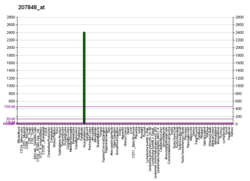
Back فازوبرسين Arabic Vazopressin Azerbaijani وازوپرسین AZB Вазапрэсін Byelorussian Антидиуретичен хормон Bulgarian ভ্যাসোপ্রেসিন Bengali/Bangla Vazopresin BS Hormona antidiürètica Catalan Antidiuretický hormon Czech AVP Welsh
 | |
 | |
| Clinical data | |
|---|---|
| Pronunciation | /ˌveɪzoʊˈprɛsɪn/ |
| Other names | Antidiuretic hormone (ADH); arginine vasopressin (AVP); argipressin |
| ATC code | |
| Physiological data | |
| Source tissues | Supraoptic nucleus; paraventricular nucleus of hypothalamus |
| Target tissues | System-wide |
| Receptors | V1A, V1B, V2, OXTR |
| Agonists | Felypressin, desmopressin |
| Antagonists | Diuretics |
| Metabolism | Predominantly in the liver and kidneys |
| Pharmacokinetic data | |
| Protein binding | 1% |
| Metabolism | Predominantly in the liver and kidneys |
| Elimination half-life | 10–20 minutes |
| Excretion | Urine |
| Identifiers | |
| |
| CAS Number | |
| PubChem CID | |
| IUPHAR/BPS | |
| DrugBank | |
| ChemSpider | |
| UNII | |
| KEGG | |
| ChEBI | |
| ChEMBL | |
| CompTox Dashboard (EPA) | |
| Chemical and physical data | |
| Formula | C46H65N15O12S2 |
| Molar mass | 1084.24 g·mol−1 |
| 3D model (JSmol) | |
| Density | 1.6±0.1 g/cm3 |
| |
| |
Human vasopressin, also called antidiuretic hormone (ADH), arginine vasopressin (AVP) or argipressin,[5] is a hormone synthesized from the AVP gene as a peptide prohormone in neurons in the hypothalamus,[6] and is converted to AVP. It then travels down the axon terminating in the posterior pituitary, and is released from vesicles into the circulation in response to extracellular fluid hypertonicity (hyperosmolality). AVP has two primary functions. First, it increases the amount of solute-free water reabsorbed back into the circulation from the filtrate in the kidney tubules of the nephrons. Second, AVP constricts arterioles, which increases peripheral vascular resistance and raises arterial blood pressure.[7][8][9]
A third function is possible. Some AVP may be released directly into the brain from the hypothalamus, and may play an important role in social behavior, sexual motivation and pair bonding, and maternal responses to stress.[10]
Vasopressin induces differentiation of stem cells into cardiomyocytes and promotes heart muscle homeostasis.[11]
It has a very short half-life, between 16 and 24 minutes.[9]
- ^ a b c GRCh38: Ensembl release 89: ENSG00000101200 – Ensembl, May 2017
- ^ a b c GRCm38: Ensembl release 89: ENSMUSG00000037727 – Ensembl, May 2017
- ^ "Human PubMed Reference:". National Center for Biotechnology Information, U.S. National Library of Medicine.
- ^ "Mouse PubMed Reference:". National Center for Biotechnology Information, U.S. National Library of Medicine.
- ^ Anderson DA (2012). Dorland's Illustrated Medical Dictionary (32nd ed.). Elsevier. ISBN 978-1-4160-6257-8.
- ^ Sukhov RR, Walker LC, Rance NE, Price DL, Young WS 3rd (1993). "Vasopressin and oxytocin gene expression in the human hypothalamus". Journal of Comparative Neurology. 337 (2): 295–306. doi:10.1002/cne.903370210. PMC 9883978. PMID 8277003. S2CID 35174328.
- ^ Marieb E (2014). Anatomy & physiology. Glenview, IL: Pearson Education, Inc. ISBN 978-0-321-86158-0.
- ^ Caldwell HK, Young WS III (2006). "Oxytocin and Vasopressin: Genetics and Behavioral Implications" (PDF). In Lajtha A, Lim R (eds.). Handbook of Neurochemistry and Molecular Neurobiology: Neuroactive Proteins and Peptides (3rd ed.). Berlin: Springer. pp. 573–607. ISBN 978-0-387-30348-2.
- ^ a b Babar SM (October 2013). "SIADH associated with ciprofloxacin". The Annals of Pharmacotherapy. 47 (10): 1359–63. doi:10.1177/1060028013502457. PMID 24259701. S2CID 36759747.
- ^ Insel TR (March 2010). "The challenge of translation in social neuroscience: a review of oxytocin, vasopressin, and affiliative behavior". Neuron. 65 (6): 768–79. doi:10.1016/j.neuron.2010.03.005. PMC 2847497. PMID 20346754.
- ^ Costa A, Rossi E, Scicchitano BM, Coletti D, Moresi V, Adamo S (September 2014). "Neurohypophyseal Hormones: Novel Actors of Striated Muscle Development and Homeostasis". review. European Journal of Translational Myology. 24 (3): 3790. doi:10.4081/bam.2014.3.217. PMC 4756744. PMID 26913138.
© MMXXIII Rich X Search. We shall prevail. All rights reserved. Rich X Search




